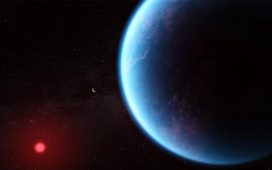- By Mark Poynting and Esme Stallard
- BBC News Climate & Science
Image source, Getty Images
Parts of northern Libya were hit by devastating flooding after extreme rainfall caused two dams to collapse
Extreme weather is becoming more frequent and more intense in many places around the world because of climate change.
Here are four ways climate change is linked to extreme weather.
1. Hotter, longer heatwaves
Even a small increase to average temperatures makes a big difference.
This is because the whole distribution of daily temperatures shifts to warmer levels, making hotter days more likely and more extreme.
Scientists use computer simulations to assess whether extreme weather events have been made more likely by warming caused by humans.
But these events are no longer rare. If global warming reaches 2C above the pre-industrial period – before humans started burning fossil fuels at scale – these events are expected to happen every two to five years, the WWA warns.
In the UK, temperatures topped 40C for the first time on record in July 2022. This would have been extremely unlikely without climate change, the WWA says.
As well as happening more frequently, heatwaves are becoming longer and more intense in many places, including the UK.
This can happen as a result of heat domes, which are areas of high pressure where hot air is pushed down and trapped in place, causing temperatures to soar over large areas.
2. Longer droughts
Linking climate change with specific individual droughts can be difficult. The availability of water depends on more than just temperature and rainfall.
But longer and more intense heatwaves can worsen droughts by drying out soil. This makes the air above warm up more quickly, leading to more intense heat.
Increased demand for water from humans, especially farmers, in hot weather puts even more stress on the water supply.
Image source, Getty Images
The East African drought hit agriculture and food security hard, displacing nearly 1.2 million people in Somalia alone, according to the World Meteorological Organisation.
3. More fuel for wildfires
But climate change is making the weather conditions needed for wildfires to spread more likely, according to the UN’s climate body, the IPCC.
Extreme and long-lasting heat draws more and more moisture out of the ground and vegetation.
These tinder-dry conditions provide fuel for fires, which can spread at an incredible speed, particularly if winds are strong.
Climate change more than doubled the likelihood of the extreme “fire weather” conditions in eastern Canada that allowed the fires to spread, according to the WWA.
Extreme wildfires are projected to become more frequent and intense in future across the globe, according to a recent report by the UN Environment Programme (UNEP). This is due to the the combined effects of shifting land use and climate change
The number of the most extreme fires may rise by as much as 50% by 2100, UNEP suggests.
4. More extreme rain
This can result in more droplets and heavier rainfall, sometimes in a shorter space of time and over a smaller area.
The destruction was exacerbated by social and political instability in the country, which hampered efforts to adequately prepare for and respond to such storms – for example by maintaining dams.
Not all extreme rainfall events can be attributed to climate change, as other factors including changes to land use can play a role. For example, the WWA says that climate change only had a “limited” role in the heavy rainfall that hit northern Italy in May 2023.
But globally, the frequency and intensity of heavy rainfall events has increased over most land regions due to human activity, according to the IPCC.
And heavy precipitation will generally become more frequent and intense with further warming, the IPCC says.











